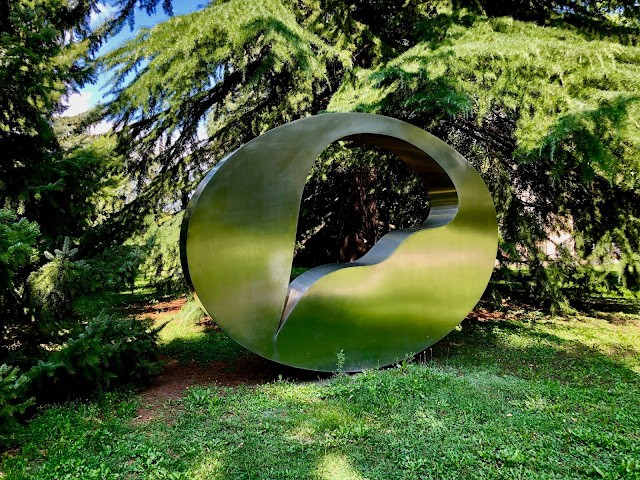Welcome back to another UBC post!
Since you guys were so enthusiastic about yesterday's post about the Bad Ragartz outdoor exhibition, I decided to share something similar that is situated at the opposite end of our country.
A few years ago I visited Martigny in the French-speaking part of canton of Valais. It is a formerly Roman town and home to the Fondation Pierre Gianadda, art collection and sculptures park.
When I was there, they were mainly exhibiting Rodin and Giacometti inside the building.
The outdoor sculptures live there permanently, though, and the giant letters spelling LOVE were the main goal of my trip! Up to a few years ago I knew about the one in NYC or Philadelphia, but had no clue there was a Robert Indiana LOVE sculpture in my very own country, Switzerland!
What else did I admire? Joan Miro's Tête (Head) and César's Pouce (Thumb).
Though simple in its design, the size and placement of the sculpture lend it a monumental feel, making it a standout piece in the Fondation's gardens. Like much of the art displayed in Martigny, this Tête interacts beautifully with its natural surroundings, offering different impressions depending on the lighting and seasons.
Interestingly I noticed that there must be several thumbs out there. One of the largest and most famous ones can be found at La Défense, Paris, France – A 12-meter (almost 40 feet) tall version is installed in the financial district.
Niki de Saint Phalle's "Les Beigneurs" (The Bathing Ones). French born Niki, wife to Swiss sculptor Jean Tinguely, is widely known for her vibrant, large-scale sculptures, especially the "Nanas"—bold, colorful depictions of voluptuous female figures.
Nana is a colloquial French word for "girls" or "women", probably best translated as "chicks".
One of Niki de Saint Phalle's Nanas, titled "L’Ange Protecteur" (The Protective Angel), hangs from the ceiling of Zurich Hauptbahnhof, the main train station.
Speaking of Niki de Saint Phalle and Jean Tinguely... I like their the Stravinsky Fountain just outside the Beaubourg aka Centre Georges Pompidou.
Back to Martigny... I enjoyed Jean Arp's "Roué Oriflamme".
I speak French, but I had no idea what this means, so I did some research. Obviously "Roué Oriflamme" suggests themes of flowing motion, duality (restraint vs. indulgence), or an interplay between grounded shapes and ascending, lofty ideals. The title might also emphasize the balance between the earthly and the ethereal, a common motif in his sculptures.
The next one is called "Stabile Mobile" by Alexander Calder. A stabile-mobile is a hybrid sculpture that integrates elements of both concepts. Calder combined a stationary base or structure (the "stabile") with moving components (the "mobile"), creating a dynamic interplay between motion and stillness. The stabile serves as an anchor, while the mobile elements extend from it, maintaining balance and kinetic beauty.
I was wondering what Max Ernst's "Le Grand Assistant" does? I mean who's he assisting? ;-)
He could symbolize a creative muse aiding the artist or a mythical guide helping humanity navigate surreal or existential realms. Alternatively, it might be an ironic title, challenging viewers to find their own meaning in its ambiguous form. As with much of Ernst's work, its true role is left intentionally open to interpretation, encouraging personal reflection.
I said it yesterday - art can be hard to "understand" or even interpret, but at the end of the day, we can just agree on the fact that we enjoy looking at these objects, right?
Did you pick a favorite?










good to know
ReplyDeleteYes, you said it correct, some we can't understand or figure out but they are still interesting and a great way to spark our imagination! My favorite is the bathing beauties, I titled that, "Girls just wanna have fun" as in the song! LOL Of course I love the Angel too!
ReplyDeleteHmm. I think maybe the girls, because they might be dancing! And the LOVE one, though I'd prefer warmer colors. I really don't like the thumbs, but as they, beauty is in the eye of the beholder.
ReplyDeleteWow! That's a colorful collection of art! All very unique. As a right-brainer, I find the skin detail in the thumb absolutely amazing. I really like the Roué Oriflamme. Looks like a place I'd like to climb and settle in with a good book!
ReplyDeleteAnother very enjoyable post! I love all your photograph! Thanks for sharing, some of the art is pretty har to understand the vision of the artist but thats the part of the art i guess :)
ReplyDeleteTamara, wow! Thanks for the additional sculpture tour! The Roue' Oriflamme has to be my favorite-- it's somehow captivating and fabulous. The thumb is perfect and very funny! But if you ever get to the Phoenix area, I can take you to another Robert Indiana LOVE sculpture and take your picture in front of it! Sculpture is fun.
ReplyDelete